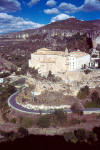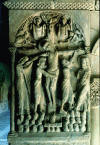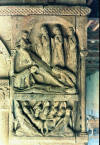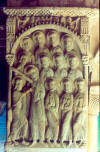|
City View of Cuenca, Spain
"In the Romanesque period, a
sharp increase in trade, fostered in part by traveling
pilgrims and Crusaders, encouraged the growth of towns and
cities. The independence towns so proudly cherished
depended on their charters. Charters were public
documents feudal lords granted, enumerating the communities'
rights, privileges, immunities, and exemptions, beyond the
feudal obligations they owed the lords. A community could
win independence by purchasing outright a charter.
Many of the new Romanesque towns rose on the sites of
ancient Roman colonies, which were restored to busy urban
life after centuries of relative stagnation. Often
located on navigable rivers, the towns were naturally the
nuclei of networks of maritime and overland commerce.
Merchants, traders, moneylenders, artisans, and free
peasants populated them."
- Gardner's
Art Through The Ages,
11th edition, Vol. I, p. 454

Convent outside Cuenca
"The new Romanesque towns
were also centers of ecclesiastical influence. Their
bishops and archbishops built towers, gates, and walls, as
well as churches. The immense building enterprise that
raised thousands of churches in western Europe in the
eleventh and twelfth centuries was not, however, due solely
to the revival of urban life. It also reflected the
widely felt relief and thanksgiving that the conclusion of
the first Christian millennium in the year 1000 did not
bring an end to the world as many had feared. In the
Romanesque age, the construction of churches became almost
an obsession.... The new churches had to be covered with cut
stone, because the technology of concrete construction had
been lost long before. The structural problems that
arose from this need for a solid masonry were to help
determine the "look" of Romanesque architecture throughout
most of Europe."
- Gardner's
Art Through The Ages,
11th edition, Vol. I, p. 454
 Note: the facade on this church
is a later,
Baroque addition.
Note: the facade on this church
is a later,
Baroque addition.
Casas Colgadas (Hanging
Houses) Day View or
Night View


(Night View photo
credit goes to Mrs. Laura Allen of San Diego)
Central Courtyard - Monastery Cloister from Santo
Domingo de Silos, Spain
"Cloister (from the Latin
word claustrum, an enclosed place) connotes being shut away
from the world. Architecturally, the medieval church
cloister expresses the seclusion of the spiritual life, the
vita contemplativa. It provided the monks (and nuns)
with a foretaste of Paradise. They walked in the
cloister in contemplation, reading their devotions, praying
and meditating in an atmosphere of calm serenity, each
withdrawing into a private world where the soul communes
only with God. The physical silence of the cloister is
one with the silence that the more austere monastic
communities required of their members."
- Gardner's
Art Through The Ages,
11th edition, Vol. I, p. 469

Capital with Demons - Santo Domingo de Silos
"[The capitals on the
columns] are variously decorated, some with abstract
patterns, many with biblical scenes or the lives of saints,
others with fantastical monsters of all sorts - basilisks,
griffins, lizards, gargoyles, and more. Saint Bernard
of Clairvaux, for example, complained that this kind of
imagery distracted the monks from their devotions: 'In
short, so many and so marvelous are [the sculpted figures]
that we are more tempted to read in the marble than in our
books, and to spend the whole day in wondering at these
things rather than in meditating on the law of God.
For God's sake, if men are not ashamed of these follies, why
at least do they not shrink from the expense?' "
- Gardner's
Art Through The Ages,
11th edition, Vol. I, pp. 469 - 471

Descent from the Cross - Santo Domingo de Silos

Burial of
Christ - Santo Domingo de Silos

Doubting Thomas - Santo Domingo de Silos

|